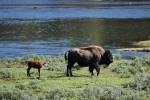Fur trapping goes over largely glitch-free in state, officials say
With fur trapping season under way in Southern Nevada, members of the trapping community have put an emphasis on safety.
Organizations such as the Nevada Trappers Association based in Northern Nevada hold annual educational events on the topic.
"It helps to educate these young trappers on proper methodology," Nevada Trappers Association president Joel Blakeslee said. "We tell people to imagine the worst-case scenario for setting a trap in a specific place. If it seems too dangerous, don't do it. Go someplace else."
Trapping is allowed on all public lands, with the exception of national wildlife refuges - of which there are seven in the state . Trapping is forbidden within 1,000 feet of trails in the Humboldt- Toiyabe National Forest or within 200 feet of a public road or highway, according to the Nevada Department of Wildlife.
Some believe the laws and regulations on fur trapping are not strict enough.
Gina Greisen, president of the nonprofit Nevada Voters for Animals, said many people are unaware that traps can be set in commonly explored areas.
"These traps are set up in such a way that you can't see them," she said. "Even a dog on a leash could walk around a rock and be caught in a trap."
She added that the required distances from trails and roads need to be extended.
However, the problem of pets getting caught in the traps is a rare occurrence, according to the Nevada Department of Wildlife. Only four dogs have been reported caught in traps in the past 15 years, according to the department.
Greisen said many cases may go unreported or remain otherwise unknown.
Doug Nielsen, a spokesman for the Nevada Department of Wildlife's southern office, said that in addition to the laws and regulations, fur trappers generally avoid heavy-traffic areas.
"Those areas don't make for good hunting," Nielsen said. "Places with a lot of people, there are no animals."
Traps with a jaw spread of greater than 5½ inches are required to have spacers that maintain a minimum opening of three-sixteenths of an inch.
"We're not talking about traps you see in Hollywood," Nielsen said. "They're on average the size of a saucer."
The law requires that all traps be checked every 96 hours, another point of contention for Greisen.
"The laws are so archaic and outdated," she said. "The (minimum visitation) needs to be shortened, the distances to public trails needs to be lengthened and the laws need to require traps to have IDs."
Greisen said some headway with government entities has been made with regard to animal rights, citing the Oct. 3 appointment of Karen Layne, president of the Las Vegas Valley Humane Society, to the Nevada Wildlife Commission by Gov. Brian Sandoval, among other victories.
"We appreciate the crumbs (the Legislature) has thrown us, but there is more work to be done," Greisen said.
Trapping in the state requires the purchase of a trapping license from the Department of Wildlife. Licenses cost $42 for residents 16 or older and $14 for residents 15 or younger.
Republican State Assemblyman Ira Hansen of District 32 has been a fur trapper since age 14 and said the traps pose no serious problems to the general public.
"The serious trappers, often called long-liners, go out in the boondocks to set their traps," he said. "And most trapping is done in the most miserable months. Not many people are hiking around in 3 feet of snow."
Hansen added that a bit of common sense goes a long way.
"You could pass all the laws in the world and still couldn't keep the stupid people from doing stupid things," he said.
The Coalition for Nevada's Wildlife, a political action committee of which Blakeslee is a director, helped successfully lobby for legislation prohibiting the use of any trapping device other than cage traps within a half-mile of residences in Clark and Washoe counties.
"This is our business. Some people trap professionally," Blakeslee said. "What we do serves a purpose, and public perception is often the biggest issue."
Nielsen agreed with Blakeslee, citing Nevada's long tradition of fur trapping.
"The sport is part of our culture," he said. "We've had a lot of people move from more urban areas, and it's difficult for them to understand that."
For more information on fur trapping, visit the Nevada Department of Wildlife's website at ndow.org.
Contact Paradise/Downtown View reporter Nolan Lister at nlister@viewnews.com or 702-383-0492.























